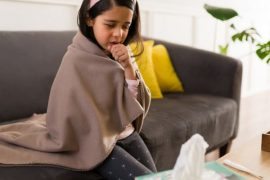Summer colds are not a serious medical condition, but they can be a big problem, especially if your toddler has a high fever. On hot days, it is even more difficult to endure than in winter. How to cope with the temperature of a child in summer? We have ways to do that.
Summer colds are not uncommon at all. It’s enough for a heated child to get into an air-conditioned car or eat ice cream just after they’ve gone mad on the beach. Fever and fever are a bad combination, so it is worth knowing how to cool the child’s body as quickly and safely as possible.
If your toddler has a runny nose, cough, feeling unwell and a warm head, you may suspect he has caught a cold despite the good weather. But before you reach for your phone or medicine, check if it’s allergic or heatstroke. The symptoms are similar, and all three ailments are equally likely on hot days.
Allergies usually begin with a runny nose, but the baby’s condition does not worsen, as in the case of a cold that develops – first the child feels bad, then a runny nose and, finally, a cough.
Allergies are rarely accompanied by a fever, but there is a cold and stroke. Heatstroke also manifests as nausea, dizziness, but not a runny nose or cough.
How to reduce the child’s temperature in the summer?
If you already know that your baby has caught a cold, try to relieve the symptoms of the disease and stop it in the bud. You can use home treatments and over-the-counter drugs recommended by pediatricians, but if the baby’s condition does not improve in 2–3 days, go to the doctor with him.
The temperature is most unpleasant in summer. Check the child’s temperature every 3–4 hours and try to lower it when it exceeds 38 °C. An adequate body temperature can make the infection less unpleasant in the summer.
Classic drugs for lowering body temperature will give children ibuprofen and paracetamol (in syrup or tablets, depending on the age of the child).
But it’s also worth cooling the child’s body with cold (not icy) compresses around the neck, head or calf. Bathing in cool water is also suitable, but be careful – the water temperature should be only 1–2 degrees below body temperature. Immersing a hot child in cold water can lead to heat shock.
Other summer temperature tricks
There are also a few other simple things you can do to improve your child’s wellbeing.
- Cool the room – try opening doors and windows, use a fan or air conditioning, or shade the windows to cool the room where the child is.
- Change your bed linen in a crib – instead of a duvet, choose a light sheet or blanket and dress your toddler in loose light pajamas. Make sure your toddler isn’t cold – it’s a common symptom of fever.
- Provide rest – despite the fact that it is summer and vacation, give the baby more rest and sleep. Avoid excessive activity and stress that can weaken his immune system. Let him stay at home.
- Take care of your child’s nutrition and hydration – a sick child should drink plenty of fluids, especially water. Avoid giving it hot tea and infusions such as raspberry or linden. They can further increase body temperature.
- Moisturize the air indoors – this will ease signs, especially runny nose, nasal congestion, sore throat and cough.








